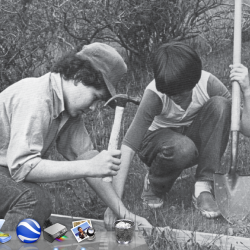Source Institutions
Source Institutions
Add to list Go to activity
Activity link broken? See if it's at the internet archive

In this highly physical outdoor activity, learners construct and compare experimental trail sections to select the best trail-construction technique for their site. As they measure, evaluate and build, they must consider factors including erosion, slope, materials, labor, cost, human effort, and various environmental impacts. The slope measuring component not only involves mathematical problem-solving, but can incorporate measurement of human health performance, since one way of measuring slope in this activity can be having learners check their pulse as they climb a hill. This activity can be well combined with the "Hold a Hill" and "Cardiac Hill" activities from the same resource.
- 1 to 2 hours
- 1 to 2 hours
- Over $20 per group of students
- Ages 8 - 18
- Activity, Field Trip, Lesson/Lesson Plan
- English
Quick Guide
Materials List (per group of students)
- meter sticks
- strong cord (125-cm length per slope-measuring device)
- sharpened sticks (25-cm per slope-measuring device)
- line levels or level tubes consisting of a test tube, popsicle stick, and a cork
- household ammonia
- water
- tape
- shovels
- hoes or rakes
- hammers and nails
- 40- to 50- cm wooden stakes
- meter tape
- boards, planks, stakes, logs, rocks, and other building materials
- graphs and other data from the activities "Cardiac Hill" and "Hold a Hill"
- several buckets of water
Subjects
-
Earth and Space Science
- Earth Structure
-
Engineering and Technology
-
Engineering
- Environmental Engineering
-
Technology
- Construction
-
Engineering
-
Life Sciences
-
Ecology
- Ecosystems
- Human Impact
-
Human Body
- Circulation
-
Ecology
-
Mathematics
-
Data Analysis and Probability
- Data Analysis
- Data Collection
- Data Representation
-
Measurement
- Rate
-
Data Analysis and Probability
-
The Nature of Science
-
The Scientific Process
- Conducting Investigations
- Gathering Data
- Formulating Explanations
- Communicating Results
-
The Scientific Process
-
The Nature of Technology
-
The Design Process
- Invention and Innovation
- Problem Solving
-
The Design Process
Informal Categories
- Nature and Environment
- Outdoor Activity
- Physical Activity
- Sports and Exercise
Audience
To use this activity, learners need to:
- see
- read
- be mobile
- touch
Learning styles supported:
- Involves teamwork and communication skills
- Uses STEM to solve real-world problems
- Involves hands-on or lab activities
Other
Components that are part of this resource:
This resource is part of:
Access Rights:
- Free access
By:
Rights:
- All rights reserved, The Regents of the University of California, 1982
